17 Types of Wood & Lumber For Building (With Pictures)
-
Pete Ortiz
- Last updated:
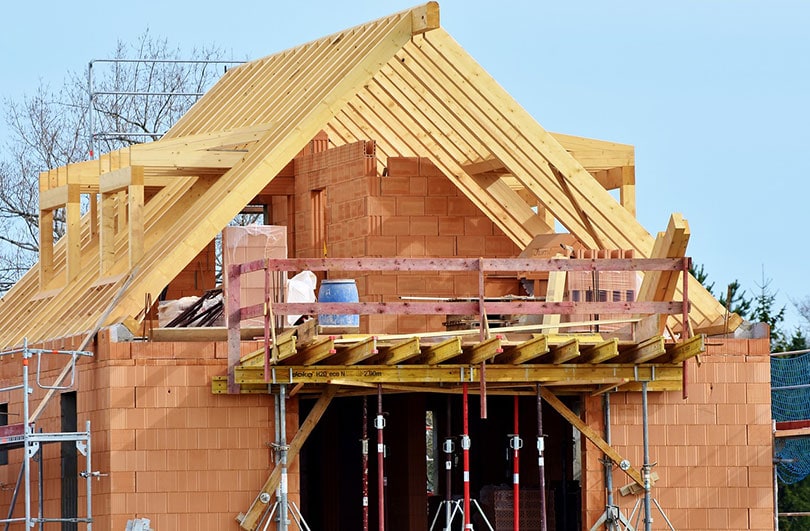
Wood and lumber are essential for building houses, and there are three main wood type categories—softwood, hardwood, and engineered wood. Each wood has its characteristics and attributes, so it’s necessary to know which type to use for your next project.
The different wood and lumber options you go for will depend on the project and what you want to achieve. We have created this list of 17 types of wood and lumber for building to help you get familiar with different wood and lumber types.
The 17 Types of Wood & Lumber for Building
1. Cedar
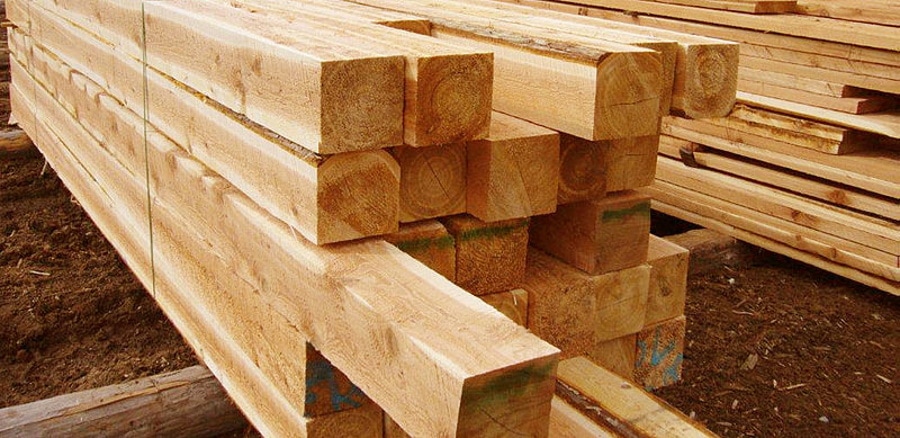
| Type of wood | Softwood |
| Color | Dark/Pinkish-red |
| Texture | Straight-grained |
| Janka Hardness Rating | 900 |
There are over 15 cedar species used for building. Cedar is distinctive due to its pleasant smell and attractive appearance. It falls into the softwood category, and it’s a very durable wood species. Cedar is not prone to warping and twisting, so it’s perfect for construction use. This wood is excellent for humid areas because it has self-protective values from mold and insects and it’s great for house siding because it doesn’t change its dimensions or size despite the weather and humidity.
Using Cedar to build is eco-friendly, so it’s a great option when building sustainable homes. This wood type requires maintenance if used outside, so make sure to treat it to maintain its beautiful appearance.
- Easy to work with
- Pleasant smell
- Self-protective
- Eco-friendly
- It needs a lot of maintenance
- Flammable
2. Cherry
| Type of wood | Hardwood |
| Color | Reddish-brown/Blond |
| Texture | Straight-grained, smooth |
| Janka Hardness Rating | 950 |
Cherry is a hardwood wood type that’s very prized in the United States. It’s among softer variations of hardwood and it’s commonly used for interior building rather than the house exterior. Most people use it for flooring, paneling, furniture, doors, and cabinetry. This wood type is easy to work with and you can shape it and carve it to your preference. Cherry wood usually lightens when exposed to sunlight, so keep that in mind when using this wood type for building.
- Beautiful color
- Low stiffness
- Not suitable for exterior work
- Color can lighten
3. Spruce
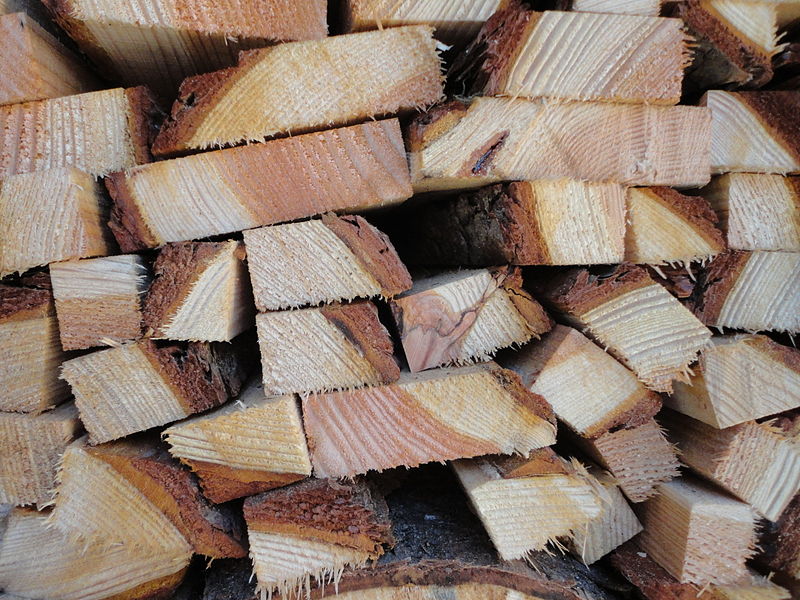
| Type of wood | Softwood |
| Color | White-yellowish |
| Texture | Straight-grained, fine |
| Janka Hardness Rating | 510 |
Spruce is a wood type similar to Pine. It is among the softest types of softwood, and it can be difficult to work with. Processing Spruce is complicated because it’s prone to cracking, although it’s among the most common types of wood used for building houses. That’s because it has a low density, making it perfect structural and building timber. Still, it needs to be chemically treated for outdoor use because it can rot quickly when in contact with the ground or in wet weather.
- Low-density wood
- Difficult to work with
- It needs processing for outdoor use
4. Redwood
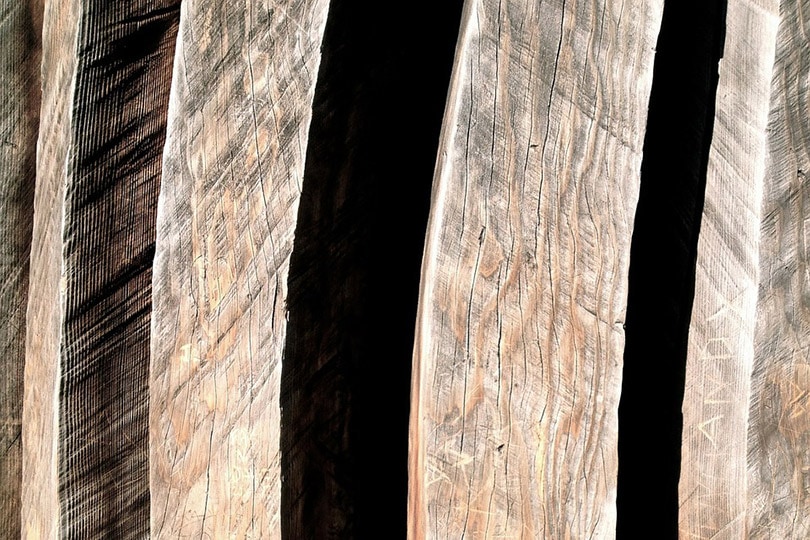
| Type of wood | Softwood |
| Color | Reddish-brown |
| Texture | Straight-grained |
| Janka Hardness Rating | 420 |
Redwood is a beautiful, long-lasting softwood with many qualities that distinguish it from other wood types. It’s resistant to warping, decay, cracking, and shrinking, making it popular to work with. Redwood is used for structural beams, trims, posts, and decking. It’s is very durable and low-maintenance and due to its stunning color, anything made with Redwood will look elegant and timeless. It is pretty expensive, but it’s well worth the price because of these qualities.
- Long-lasting
- Stunning color
- Low-maintenance
- Expensive
5. Oak
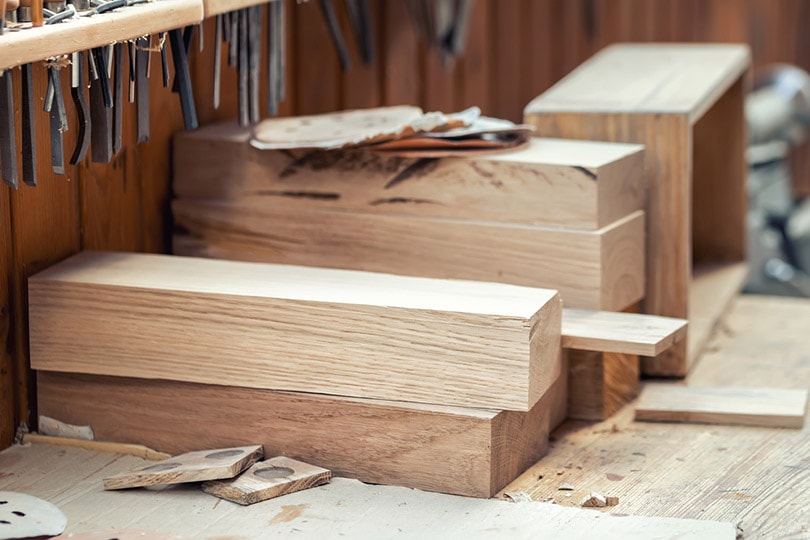
| Type of wood | Hardwood |
| Color | Light beige, brown, can have reddish hues |
| Texture | Uneven, straight-grained |
| Janka Hardness Rating | 1360-1290 |
Oak is among the most popular types of wood used for building houses. There are two Oak types, Red Oak and White Oak. This timber is durable and attractive, making it usable for many different purposes, although Oak is quite heavy. It’s water and fungi-resistant, so it’s perfect for exterior usage. Oak is another environmentally friendly wood type suitable for sustainable homes. It is very flexible, and people mostly use it for exterior cladding and hardwood floors.
- Flexible
- Water-resistant
- Fungi resistant
- Environmentally friendly
- Heavy
6. Maple

| Type of wood | Hardwood |
| Color | White with brown-reddish hues |
| Texture | Smooth-grained |
| Janka Hardness Rating | 1450 |
Maple is a wood species divided into soft and hard Maple. As the name suggests, hard Maple is more durable than soft Maple. Under the hard Maple category, we count just one Maple species known as Acer Saccharum. On the other hand, multiple Maple species fall into that category for the soft Maple. Both types are used for building, mainly for indoor uses such as making hardwood floors, cabinetry, or furniture. It’s low maintenance, affordable, and can be a beautiful natural element of any home. Maple is not as durable as other wood types, so people don’t use it for outdoor or structural work.
- Amazing hardness
- Low-maintenance
- Affordable
- Not suitable for outdoor use
7. Pine
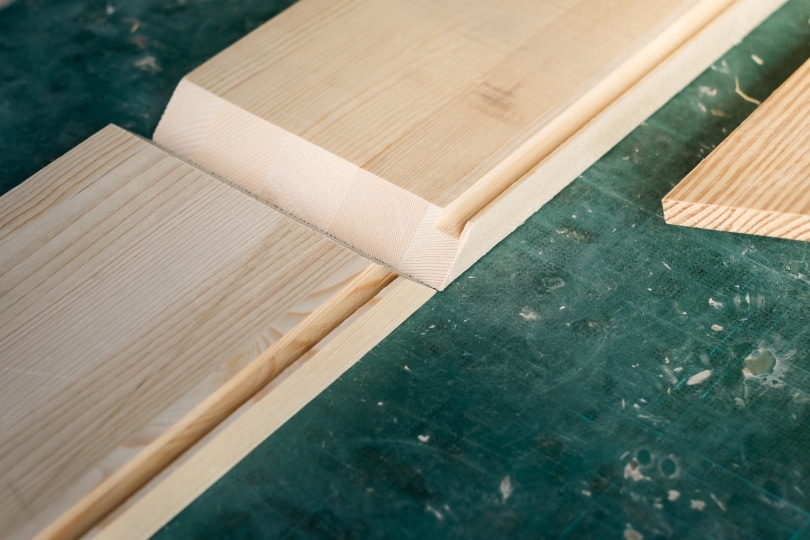
| Type of wood | Softwood |
| Color | White, pale yellow |
| Texture | Fine, uneven |
| Janka Hardness Rating | 380-1570 |
Pine is a softwood species that makes an excellent building material. That’s why we classify it into types of wood used for building houses. Regardless of it being a softwood, it is very durable and stiff. Due to its natural light color, people choose it to enhance their home aesthetics on the inside, while they use it for its known durability outside. Pine is shock-resistant and lightweight, making it perfect for use in construction. This lumber is another eco-friendly option.
- Durable
- Stiff
- Shock-resistant
- Lightweight
- More likely to get damaged than other woods
8. Ash
| Type of wood | Hardwood |
| Color | Light brown, beige |
| Texture | Smooth-grained |
| Janka Hardness Rating | 1320 |
Ash is a durable hardwood that’s shock-resistant and relatively lightweight compared to other hardwood species. It can easily bend so it’s not hard to work with. It is not as expensive as other hardwoods with similar characteristics, so that’s why many people go for ash rather than other hardwoods. Ash is more manageable for maintenance than other hardwoods, and you can use it for hardwood flooring, cabinetry, and furniture.
Regardless of Ash being durable, it’s not one of the best types of wood used for building houses, so Ash should be used in the interior only. When processed, this wood type has a slightly unpleasant odor, so it’s good to wear a mask when processing Ash.
- Shock-resistant
- Lightweight
- Affordable
- Has a mild odor while being processed
- Not suitable for outdoor use
9. Hemlock
| Type of wood | Softwood |
| Color | Pale reddish-brown |
| Texture | Hard, coarse-grained, uneven |
| Janka Hardness Rating | 500 |
Hemlock is a lightweight, strong softwood, and it’s commonly used for house building and other building projects. Hemlock’s primary usage in building is sub-floors, framing, sheathing, and roofing. People use it for stairs, fences, or shutters in interior design. This lumber type is very similar to hardwood because it’s strong and not prone to warping. It’s pretty affordable and holds stains and paints well. Although it has many great qualities, like every other wood, Hemlock has some disadvantages. It’s not the most durable wood on the market, it can be prone to splinters, plus, it’s relatively hard to work with.
- Inexpensive
- An excellent substitution for hardwood
- Lightweight
- Strong
- Not too durable
- Difficult to work with
- Prone to splinters
10. Beechwood
| Type of wood | Hardwood |
| Color | Light brown, beige-pinkish |
| Texture | Straight-grained |
| Janka Hardness Rating | 1300 |
Beechwood is a non-durable hardwood with good workability and is generally easy to process. Its general use is for building furniture, flooring, cabinetry, and door construction. It’s pretty hard and doesn’t easily scratch, so this type of hardwood floor is very popular with homeowners. Beechwood is quite a heavy wood species, and it absorbs water fast. That’s why you should use it just for the interior. It has to be stained and polished so that it doesn’t crack if used outdoors.
- Good workability
- Easy to process
- Hard
- Not prone to scratching
- Non-durable
- Absorbs water fast
- Heavy
11. Teakwood
| Type of wood | Hardwood |
| Color | Golden-honey brown |
| Texture | Straight-grained |
| Janka Hardness Rating | 1155 |
Teakwood is a high-quality hardwood that has various uses. It has a stunning golden-honey brown color, and is trendy due to its durability and unique appearance. Teakwood is used for furniture, decking, boat building, and exterior construction. When considering types of wood used for building houses, teakwood should be on your list.
It’s water and decay-resistant but is an expensive hardwood that requires a lot of maintenance, so have that in mind before starting your building project. Also, this lumber is quite hard to work with due to its high density.
- High-quality
- Stunning color
- Water-resistant
- Decay resistant
- Durable
- Expensive
- Difficult to work with
- Requires a lot of maintenance
12. Balsa
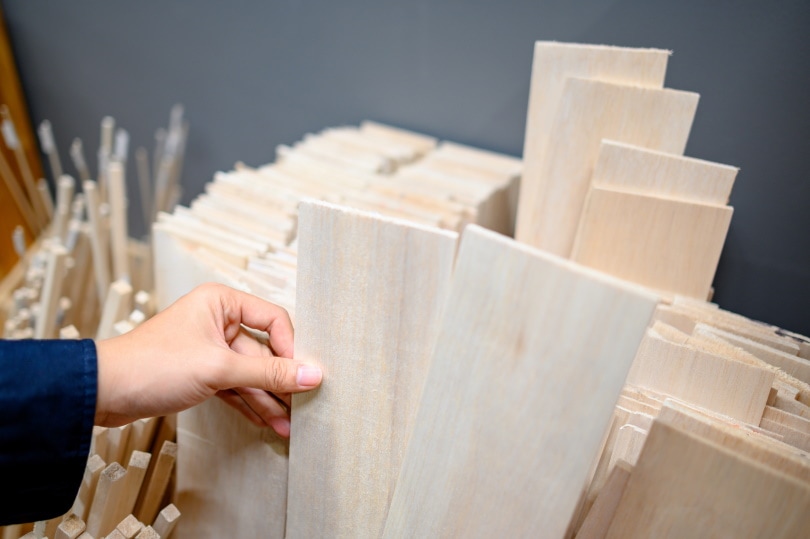
| Type of wood | Hardwood |
| Color | Light beige |
| Texture | Straight-grained |
| Janka Hardness Rating | 100 |
Although considered a hardwood, Balsa is a very soft wood species with a Janka Hardness Rating of only 100, which is among the lowest on the scale. People use Balsa for insulation, model building, furniture, and carving. It’s easy to work with due to its low density. This is another affordable hardwood, but it does have disadvantages. The main ones are that it’s highly flammable, not very durable, and it’s prone to insect and water damage.
- Easy to work with
- Low-density
- Affordable
- Highly flammable
- Not very durable
- Prone to insect and water damage
13. Poplar
| Type of wood | Hardwood |
| Color | Light brown with white and green hues |
| Texture | Straight-grained |
| Janka Hardness Rating | 540 |
Poplar is a budget-friendly hardwood with attractive colors and multiple usages. It’s pretty strong, so its everyday use is to build furniture, cabinets, trims, decorative molding, and pallets. Regardless of Poplar being a hardwood, it’s quite soft and not as durable as other hardwoods are. It is easy to work with because it’s lightweight, but it’s prone to scratches and dents. Poplar is a hardwood option that you can use for various things, but keep in mind that it’s more prone to damage than other hardwoods.
- Budget-friendly
- Strong
- Lightweight
- Easy to work with
- Not as durable as other hardwoods
- Prone to scratches and dents
14. Douglas Fir
| Type of wood | Softwood |
| Color | Whitish, pale yellow-pinkish |
| Texture | Straight-grained, can be wavy/curly occasionally |
| Janka Hardness Rating | 660 |
Douglas Fir is a highly durable softwood that is resilient, strong, and can bear inclement weather, making it perfect for building houses. It’s primarily used in flooring, trim, joinery, furniture making, and decking.
- Good shade coverage
- Beautiful autumn foliage
- Strong
- Hardy
- Soft
- Easily damaged
Engineered Woods
15. OSB (Oriented Strand Board)
| Type | Solid panel |
| What’s it made from | Poplar, pine, mixed hardwood species |
OSB is a building material usually made from poplar, pine, and mixed hardwood species. OSB’s are engineered wood panels, and they are one of the most common materials used for structural construction. It is very affordable, and since it’s cheaper than hardwoods, people use it for various DIY projects. OSB is very strong, has high density, and can be used for indoor and outdoor uses. It’s also water-resistant, so you won’t have to worry about damages from bad weather. It’s pliable, so we don’t recommend using it for flooring due to possible squeaking.
- Strong
- Inexpensive
- Has high-density
- Water-resistant
- Pliable
- Looks unfinished
Related Read: 7 Different Types of Engineered Wood (with Pictures)
16. Hardboard
| Type | Fiberboard |
| What’s it made from | Residual wood fiber (chips and shavings) |
Hardboard is another engineered wood type that’s one of the common types of wood used for building houses. Hardboard is mainly used for roofs and partitions, but you can also make furniture or doors. It’s very low-maintenance, exceptionally durable, and looks nice. It’s not the most beautiful product out there, but people often use it due to its affordable price and good qualities. Hardboard is an eco-friendly material that is quite heavy and doesn’t have a natural look. It’s also not water-resistant without additional treatment, so remember that before you decide to use it for your projects.
- Low-maintenance
- Durable
- Affordable
- Eco-friendly
- Not water-resistant
- Heavy
- Doesn’t have a natural look
17. Plywood

| Type | Solid panel |
| What’s it made from | Thin sheets of veneer peeled from debarked wood |
Plywood is an engineered wood option made from thin sheets of veneer peeled from debarked wood. It has an attractive look and it’s solid, so it’s commonly used for building. Plywood is also durable and comes in various sizes. It is versatile and affordable, so many people choose it when building or doing DIY projects. You always need to cover Plywood with a laminate finish, though, because you can see layers of veneers at the edges.
- Attractive look
- Solid
- Durable
- Comes in various sizes
- Needs to be covered with a laminate finish
Conclusion
There are various types of wood used for building houses and other projects. You can choose anything from hardwoods, softwoods, or engineered wood. Before you begin, familiarize yourself with all the species and their advantages/disadvantages. Consider all the details, such as workability, durability, and price, and then make your choice. If you need a reminder, you can always come back to this article and check out the pros and cons of each wood type we mentioned.
You might also be interested in:
- What Is Green Lumber? Kiln-Dried vs. Green Lumber Compared
- What Is the Best Wood for Floors?
- How to Dry Wood Fast with a Solar Kiln
Featured Image Credit: Ralphs_Fotos, Pixabay
Contents



